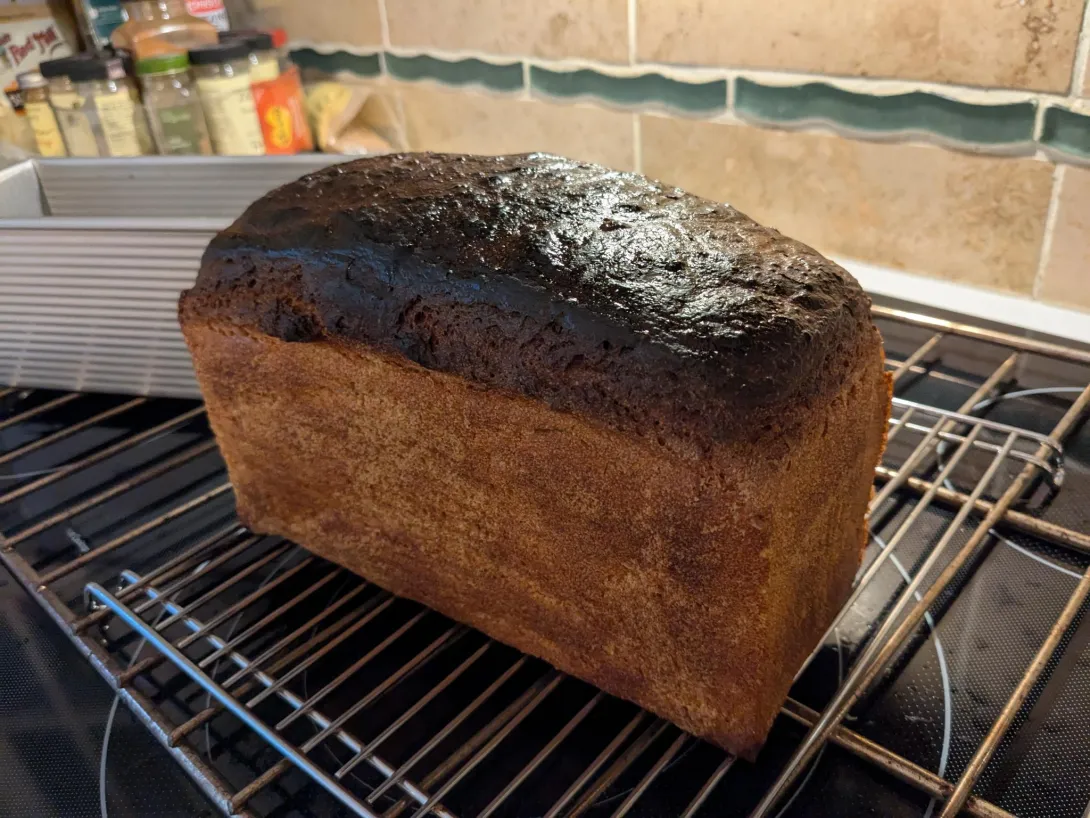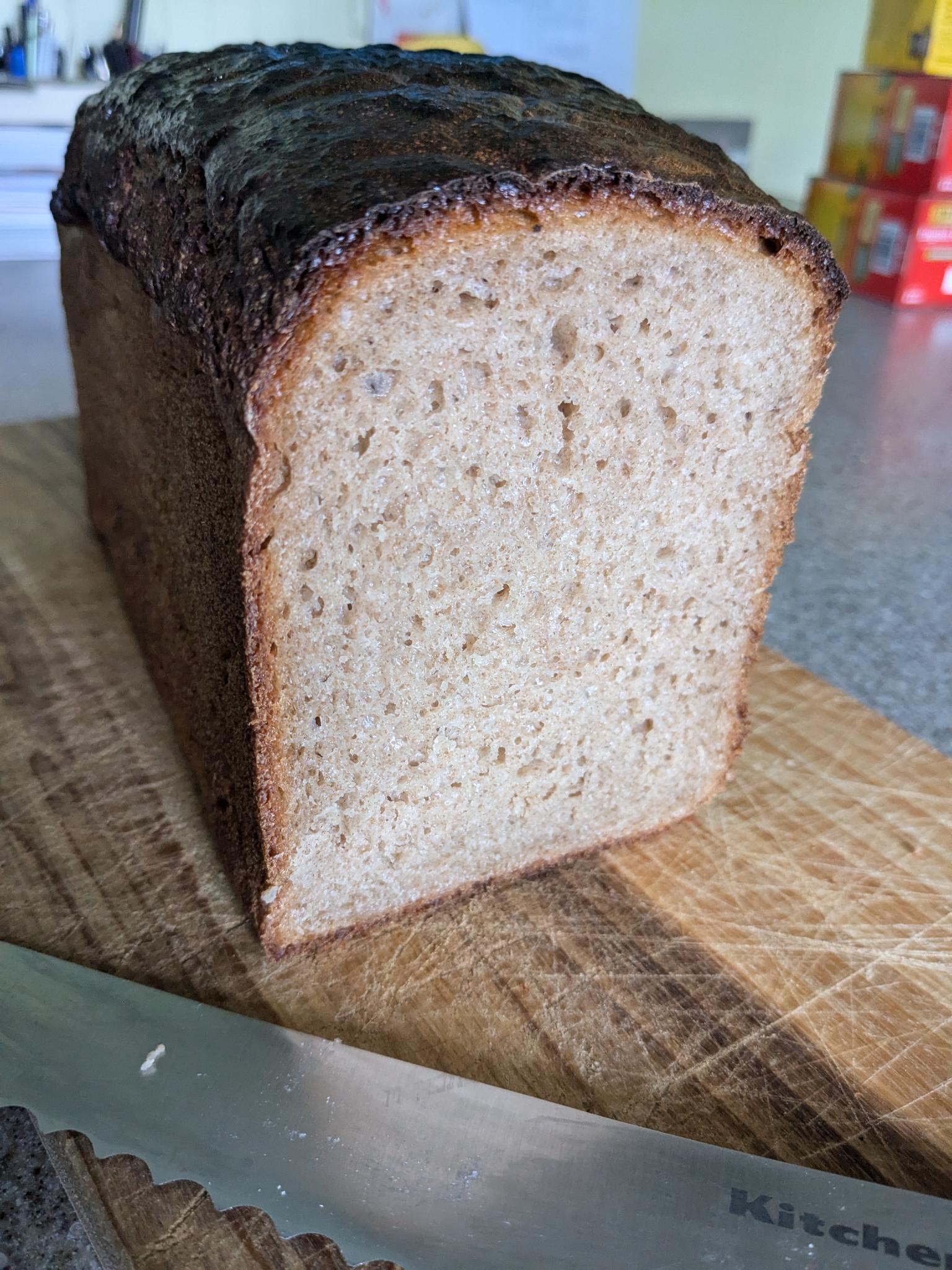
I just finished creating my first bread from Ginsberg's book. All seemed to go well with the recipe until the end of the bake. Nice rise, nice oven spring, really nice smell as it baked. Everything.
Here's the timing of my bake:
- 20 min for the oven to reach (nominal) 460 F.
- 20 min at that high temp, after which I turned down to (nominal) 375 F.
- 25 min later the top was looking very dark, so I tented with foil.
- 15 min after that, I removed from oven.
So that's a total of 80 min from the time I turned oven on until I turned it off.
BUT... when I did take the bread out, the top crust was so hard that it was difficult to get my Thermapen Mk 4 to pierce it. And when I finally did get it through the roof armor, I read an internal temp of 208 F.
I immediately boiled up some water and painted a liberal coat onto all six faces.
I hope that after all the time and effort—and anticipation—I haven't turned it into a lead-lined cinder.
I was also irked by an instruction that I find to be quite ambiguous. Ginsberg's guidance for how to proceed after you've turned the oven down reads thus:
"continue baking until the loaf thumps when tapped with a finger and the internal temperature is at least 198F/92C, 75–80 minutes." [emphasis added]
My intuition told me that 75 or 80 add'l minutes after the 40 min was a lot, but for all I knew, this was just one more way in which the Wonderful World of Rye differed from my decades of experience confined to Wheatland. Now I'm thinking he may have meant "75–80 minutes total," which is to say, "a further 35–40 minutes."
I don't believe that my oven runs particularly hot, since most of the time I find that the times given in others' published recipes are pretty close to what I do need. I'm wondering if this is just one more example of the, umm, eccentricities in Ginsberg's instructions. My next opportunity to gather more data on that point will come two days hence when I slice into the thing.
Be that as it may, I should have known to check the temp sooner, especially because I had seen that the top crust was getting darker than I'd have expected. But again in my defense, I figured, "For all I know, this is why it's called 'black' bread."
- PJT's Blog
- Log in or register to post comments
That looks great. I like the shine the boiling water imparted to the crust. I'll have to try that the next time I bake this one.
I think you'll be surprised by the outcome. I made this one a few years ago so I checked my notes. I baked for 20 min at 460 °F and 70 min at 375 °F; I didn't record the oven warm-up period. I wasn't consistently measuring (or recording) crumb temperature back then, so I don't have a value for that. I also find that many of the German rye breads have very hard top crusts so I poke the temperature probe from the bottom.
My top crust was also pretty dark like yours, but the crumb was open and, IIRC, moist. Post a photo of the crumb after you slice it; I'll be curious how you like it.
Thanks for your reply; it gives me reason for hope :-)
I will indeed let you know how it turns out.
Looking forward to the crumb shpt and hearing how it tastes.
On another note... An interesting fact. Frisian is the closest language to English. West Frisian to be precise (there are different dialects). When I hear it being spoken I imagine it is what English sounds like to someone who doesn't speak English.
I've just sliced into it, some 45 hours after it came out of the oven. The crumb is nice. And I really like the flavor, fairly sour but also sweet. Sad to say, my wife describes it as not among her favorites. not among her favorites.
not among her favorites.
It looks great, that's for sure. And it sounds like a flavor I would like.
TomP
Your crumb looks almost identical to the loaf that I made. I guess Ginsberg's formula is reproducible. Another observation I have made is that many of the crumb temperatures he lists do not always correspond to the value I obtain.
I also remember that the flavor was on the upper end of sour for that bread. I have the same experience as you do—the other household member does not really care for most rye breads.
I think your bread looks lovely and like Tom, from how you describe it, it sounds like a flavour i'd like.
And like alcophile said most of the rye breads i've seen which are based on The Rye Baker recipes seldom look exactly like the photos. Possibly because he might be using a different variety and grind of rye. I imagine he uses the exact type of flour called for and most probably people use what;s available to them.
As with your wife, my wife doesn't enjoy rye breads as much as I do. Since I'm the primary bread baker and consumer in our house, I just keep making them.
You have produced a very attractive loaf in spite of the ambiguity in Stan's instructions.
Paul
That is a handsome loaf, I particularly love its loft and the dark shine on the top crust. I’ve said this before, but I wish I enjoyed rye more because so many of the rye breads are interesting to me.
Benny
I love extra dark crust! Nice bake, PJT
Jay
That’s a picture perfect bake. I will have to look this one up in the book as I don’t recall the formula. It’s certainly a beautiful looking loave.
Best,
Ian